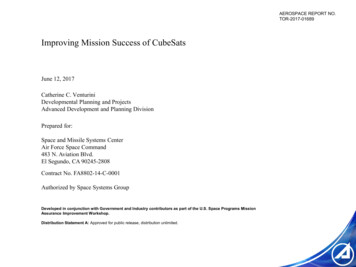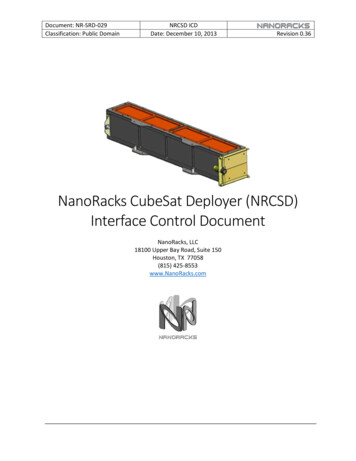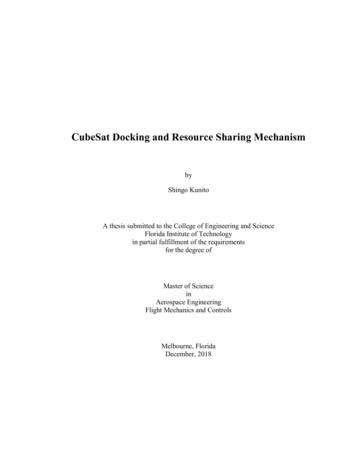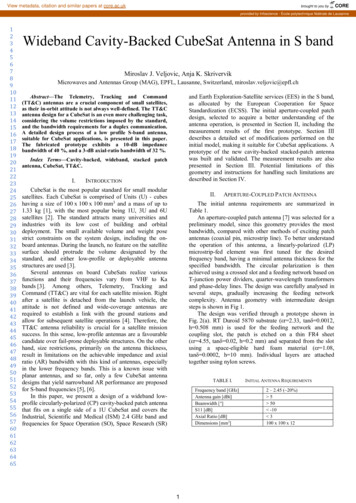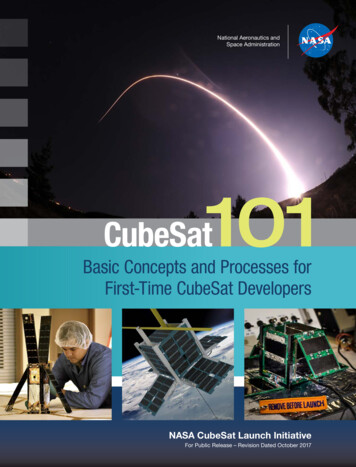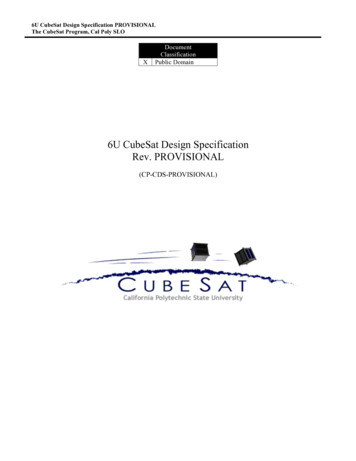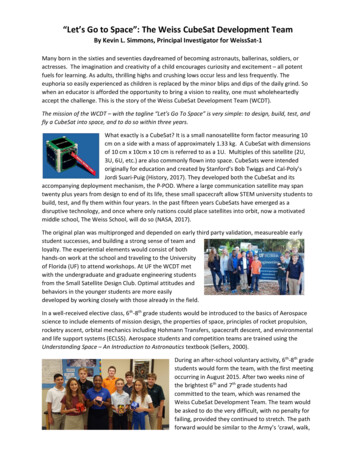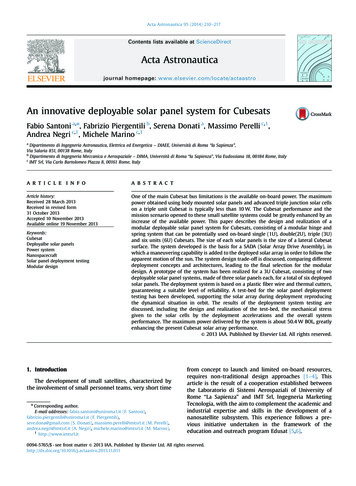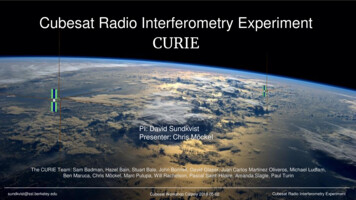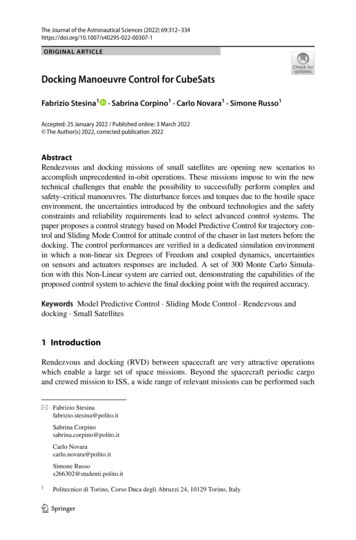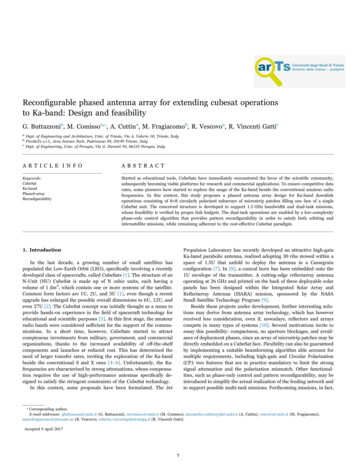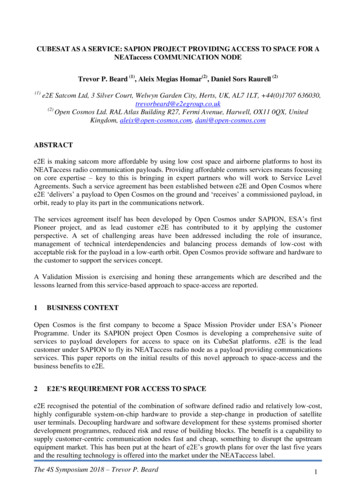
Transcription
CUBESAT AS A SERVICE: SAPION PROJECT PROVIDING ACCESS TO SPACE FOR ANEATaccess COMMUNICATION NODETrevor P. Beard (1), Aleix Megias Homar(2), Daniel Sors Raurell (2)(1)e2E Satcom Ltd, 3 Silver Court, Welwyn Garden City, Herts, UK, AL7 1LT, 44(0)1707 636030,trevorbeard@e2egroup.co.uk(2)Open Cosmos Ltd. RAL Atlas Building R27, Fermi Avenue, Harwell, OX11 0QX, UnitedKingdom, aleix@open-cosmos.com, dani@open-cosmos.comABSTRACTe2E is making satcom more affordable by using low cost space and airborne platforms to host itsNEATaccess radio communication payloads. Providing affordable comms services means focussingon core expertise – key to this is bringing in expert partners who will work to Service LevelAgreements. Such a service agreement has been established between e2E and Open Cosmos wheree2E ‘delivers’ a payload to Open Cosmos on the ground and ‘receives’ a commissioned payload, inorbit, ready to play its part in the communications network.The services agreement itself has been developed by Open Cosmos under SAPION, ESA’s firstPioneer project, and as lead customer e2E has contributed to it by applying the customerperspective. A set of challenging areas have been addressed including the role of insurance,management of technical interdependencies and balancing process demands of low-cost withacceptable risk for the payload in a low-earth orbit. Open Cosmos provide software and hardware tothe customer to support the services concept.A Validation Mission is exercising and honing these arrangements which are described and thelessons learned from this service-based approach to space-access are reported.1BUSINESS CONTEXTOpen Cosmos is the first company to become a Space Mission Provider under ESA’s PioneerProgramme. Under its SAPION project Open Cosmos is developing a comprehensive suite ofservices to payload developers for access to space on its CubeSat platforms. e2E is the leadcustomer under SAPION to fly its NEATaccess radio node as a payload providing communicationsservices. This paper reports on the initial results of this novel approach to space-access and thebusiness benefits to e2E.2E2E’S REQUIREMENT FOR ACCESS TO SPACEe2E recognised the potential of the combination of software defined radio and relatively low-cost,highly configurable system-on-chip hardware to provide a step-change in production of satelliteuser terminals. Decoupling hardware and software development for these systems promised shorterdevelopment programmes, reduced risk and reuse of building blocks. The benefit is a capability tosupply customer-centric communication nodes fast and cheap, something to disrupt the upstreamequipment market. This has been put at the heart of e2E’s growth plans for over the last five yearsand the resulting technology is offered into the market under the NEATaccess label.The 4S Symposium 2018 – Trevor P. Beard1
Early NEATaccess market penetration is (1) for legacy satcom user terminal variants and (2)providing beyond-line-of-sight links between ground control stations and drones. Drone linksinclude installation of NEATaccess onto small flying vehicles – this is possible because ofequipment miniaturisation and low power requirements - and already demonstrates use of thetechnology for non-ground terminals.The e2E strategy to grow this business includes application of NEATaccess to other flying or spaceplatforms to provide command and control links and also to use hosted comms payloads to provideend-user communication services. Deploying NEATaccess to high altitudes and into spaceintroduces technical issues and challenges beyond its current design parameters and capabilities.This business opportunity can only be realised by developing NEATaccess to make it space-readyand following this with an in-orbit demonstration. The initial demonstration will allowcharacterisation of ground-to-space communication performance and also of the resilience of theunderling hardware and software technologies. Furthermore it will demonstrate how usefulcommunications services can be delivered using this capability. An extended operational period isrequired to allow for thorough and flexible testing and also to respond to those results by uploadingnew payload (and ground segment) system builds to hone techniques and apply improvements aspart of the demonstration. As a software defined radio even significant changes can be introduced aspart of operations; this can include changes to the modems right through to updated service-levelapplications.As an SME e2E is managing its R&D budget very carefully with sharp focus on its core capabilityof communications node development and layered services. e2E’s requirement is for a low-cost,low-friction solution to place a NEATaccess payload in space so that the demonstration mission canbe accomplished. Furthermore during the operational period e2E wishes to maximise the time andeffort allocated to driving, testing, evaluating and improving the communications; the associatedchallenges of operating and maintaining the spacecraft hosting the payload should have as small animpact as possible on e2E’s work. The spacecraft and its surrounding development and operationsprogramme is seen from e2E’s perspective as just another piece of necessary infrastructure; the goalis to partner with a specialist which will deal with this so that e2E’s focus can remain where itbelongs.3CUBESAT TECHNICAL SOLUTIONThe objective of ESA’s Pioneer Programme is to support the emergence of space mission providerssuch as Open Cosmos with the aim to facilitate the demonstration of new and advancedtechnologies, systems, services and applications in the space environment. The programme wasconceived to lower space mission development barriers faced by entities wishing to validate newand advanced solutions in orbit, stimulating proof of concept flight opportunities that will allowsatcom industry companies to enlarge market opportunities in services, applications andtechnologies.In the last decade the space industry has seen how nanosatellites have increased their performancein orbit with CubeSat standards [1] easing the path of spacecraft design and subsystemsminiaturisation. By using standardised interfaces and processes together with industry bestpractices, the entire development of a mission can be simplified, massively reducing its costs andtime to orbit. This includes the use of deployable systems, launch ride-sharing and flexibility with amuch less demanding platform in terms of power, mass and volume. The potential andfunctionalities of standardised CubeSat platforms has been more than proved in the recent years,The 4S Symposium 2018 – Trevor P. Beard2
with constellations mapping the Earth with revisit times never seen before. Moreover, the new smalllauncher players appearing in the market with re-usability capabilities supporting tailored orbits inLEO that allow frequent revisit times, passive non-risky re-entries and shorter flying distances, is aclear sign that micro and nanosatellites are the right means to advance towards simplifying access tospace.Open Cosmos has been tackling the three major barriers that have kept satellites aside from thebroad audience of possible payload developers, namely: complex technology, time-consumingpaperwork and extremely high costs. This is achieved with qbkit, a payload development platform,and qbapp, a cloud-based mission and system simulator. qbkit replicates the mechanical andelectrical interfaces and constraints of Open Cosmos' satellite platforms while still being modularand flexible to enable payload developers to change the physical dimensions and configurationduring development. qbkit allows system level functional and environmental testing without theupfront cost of acquiring engineering/flight models for the subsystems and platform. qbapp enablesfull mission and systems development and simulation with hardware-in-the-loop when the payloadis assembled in qbkit. It also simulates the behaviour of the platform configured by the useremulating its performance and constraints from the orbital parameters and subsystems selected.Figure 1. qbee platform CAD modelWith these tools that simplify mission and payload development together with making use ofCubeSat platforms and standards [1], the flexibility to accommodate all kinds of payloads ismaximised. In this specific SAPION project, communications modules and antennas are beingintegrated from the very beginning when qbkit is sent to e2E and credentials are distributed toprovide access to qbapp. Once the payload has been properly integrated and tested in qbkit andthrough qbapp, e2E will send back to Open Cosmos the qbkit with the payload integrated for finalThe 4S Symposium 2018 – Trevor P. Beard3
assembly into the qbee satellite platform. qbee is Open Cosmos’ satellite technology solutiondeployed into space which is compatible with everything that the customer develops in qbkit andqbapp, enabling ‘plug and launch’. qbee is available in the 12U, 6U, 3U, 2U and down to 1U formfactors, being 3U the selected size for the SAPION project. Open Cosmos is using in-housedesigned as well as third-party subsystems to support payload and mission requirements and todirectly address a full range of capabilities, lead-time performance and costs.4SPACE ACCESS AS A SERVICESince the first service concept designs, efforts were focused on simplifying the process of sendingpayloads to space with a minimalistic approach. Open Cosmos has been analysing in a pragmaticway the main actors, activities and documents involved throughout standard spacecraft missiondevelopment. Going in depth within each necessary process was a key factor, being critical havingprevious experience and expertise in the sector to capture the essence of each procedure, its maindriving factors and the main key players.Table 1. Preliminary product tree of the SAPION projectLevel 1Level 2: PhaseLevel 3: segmentLevel 4: productHardware toolqbkitSoftware toolqbappDevelopmentSpace SegmentPlatformPayloadOperations segmentqbapp OPSLaunch SegmentLaunchGround SegmentMissionAutomatic booking systemGround station network ling services segmentSpace Activities LicenseFrequency filingApplicationsSpace and ground segmentCustomer store-n-forward serviceService Terms & ConditionsLegalsContractsExport controlCustomer supportIntellectual PropertyProgrammatics/ManagementEnd-to-end SMP managementConsultancyMission Feasibility studiesMarketingWebsitePromotional materialThe 4S Symposium 2018 – Trevor P. Beard4
Following the simplification of access to space approach, a list of services was finally providedfrom Open Cosmos to e2E. The main services provided are: mission and payload developmentservices (qbkit, qbapp), spacecraft platform services (qbee), Assembly Integration and Testing(AIT), frequency allocation, legal support, ground segment, launch procurement, commissioning,orbital phase operations and decommissioning services mainly. This list of services is clusteredunder the full space mission provider service which can be divided in four main phases withdifferent segments and numerous products as described in Table 1.There is a level 5, not included in Table 1, that corresponds to the Components level which theproducts are composed of.As lead customer, e2E was presented with a draft of the Open Cosmos services agreement. Thecontract review work took a collaborative approach with Open Cosmos and its lawyers with e2Ebeing able to bring a focussed customer perspective with the intent of achieving clarity andconcision. Getting the services agreement right is an important element of reducing friction forclients; a protracted contractual negotiation period is not consistent with the vision to deliverpayloads into orbit rapidly and cheaply. The work with e2E forms an investment in this part of theservice acquisition process.The primary areas which were addressed and clarified as part of the services agreementcollaboration indicate areas of challenge for delivery of such services and these are set out here. Thesatellite ownership transition point required careful definition and must match with regulatory andinsurance conditions. Very clear statements about levels of risk have been derived so that it is clearto the service provider and user the liabilities in the event of technical problems e.g. launchproblems; words also capture the nature of how the payload developer and Open Cosmos engage tomake design decisions, selection of options and to solve technical problems if they arise. Codifyingthe level of interaction required by the customer’s payload development team and Open Cosmos’team providing services is a critical aspect. The services agreement also captures the delivery andusage of qbkit and qbapp and is backed up by a technical interface definition explaining thepossibilities for payload hosting and to provide guidance in payload definition.In the future, the generation of service agreements and the acceptance of the qbkit and qbapp termsand conditions are planned to be offered online in qbapp and be based on customer requirements.This will be performed in an interactive way throughout dedicated areas in qbapp portal where thecustomer will be able to supervise the status and development process of the mission.5TECHNICAL COLLABORATION AND SOLUTIONAs the first user of the Open Cosmos consolidated services, e2E has been using early adopterversions of information, software and hardware which form the tangible engineering artefacts forthe payload developer using the services. e2E’s role within SAPION includes exercising theseartefacts, providing feedback and working constructively to support Open Cosmos in its continuousimprovement approach. There are number of key artefacts and these are discussed here.The process-flow definition through which Open Cosmos provides its services, captures the way inwhich the customer engages with Open Cosmos, e.g. in use of qbapp at an early stage to exploremission options, satellite payload resource demands and how these match the qbee options andcapabilities. The processes themselves are being applied on SAPION and this has clarifiedimportant aspects including the necessary conditions for information and decisions to guideprogression through the project in an efficient and controlled way. Iteration is supported inThe 4S Symposium 2018 – Trevor P. Beard5
important areas including mission design and technical trade-offs, but with certain key stagesestablishing baselines, for example the decision point where the launch is reserved.e2E has found the qbapp mission analysis functions highly valuable in determining the groundvisibility and satellite passes and the corresponding power and data profiles to deliver payloadfunction. The ability to run scenarios with altered sets of parameters to determine performanceenvelopes and carry out sensitivity analysis has been found very valuable; for e2E communicationsthe mission characteristics translate into what can be delivered as communications throughput andlatency. A qbapp screen showing mission analysis outputs is shown in Figure 2. e2E has beenfeeding to Open Cosmos input on qbapp features and on relative priority of forthcoming functions;Open Cosmos has responded accordingly in its agile software development.Figure 2. qbapp mission analysis used by the customerThe services include a document set to control the technical interface between the customer’spayload and the qbee platform. Open Cosmos is building this specification under SAPION and ithas been found effective to assess it alongside development of e2E’s payload and associateddevelopment work. e2E and Open Cosmos engineers have been engaging directly within SAPIONto achieve the right level of interface specification and control; the objective for future missionswithin the service agreement is to arrive at an interface definition which is comprehensive andclearly expressed for generically available features and a template-filling approach to agree specificinterface decisions. This will ensure the minimum necessary constraints are placed on payloaddevelopers whilst allowing them to maximise how self-sufficient they can be in establishing theintegration solution.e2E has found provision of qbkit CAD files invaluable to support decisions on mechanical andthermal interface points; backed up by having the qbkit on the bench providing context for initialmechanical design decisions. qbkit is in active use in conjunction with payload engineering modelactivities in particular for electrical interfaces and the software and data interactions with theThe 4S Symposium 2018 – Trevor P. Beard6
payload. One area of feedback to Open Cosmos has been the high value of providing an API toqbapp to allow automation of payload tests during development and also to enable e2E to build alightweight, layered payload control system for use during development and operations.Other interface elements address supply of information to Open Cosmos from the customer so thatit can meet its regulatory and safety obligations, e.g. to declare the materials used within thepayload. This is specified in the service agreement and also explained as simple requirementswithin a payload guidelines document. This has been found to be a challenging area and is likely tobe so for many of Open Cosmos’ customers making the transition to deploy in space. Open Cosmosand e2E are exploring ways in which the services can more directly, clearly and simply provideguidance and support to putative payload developers to help them develop robust, recoverable andeffective systems for the low Earth orbit environment.e2E has found having qbkit to use directly within its development lab to be invaluable. It is anefficient tool for considering all aspects of the payload design from physical layouts to electricaland data interfaces. A picture of e2E’s qbkit integrated with a payload engineering model used fordata interfaces is shown in Figure 3.Figure 3. qbkit being used with a payload engineering modelThe Interface Control Document (ICD) together with the qbkit and qbapp user manuals wereconceived to smooth the payload development and testing. An innovative approach has beenintroduced with the user manuals as they are online available through qbapp with interactivevisualisations that are intended to ease the integration of the payload into qbkit.Regular meetings and reviews have proven to be of great value to adapt both sides into a solidsolution that fulfils the mission requirements and objectives of the SAPION project.The 4S Symposium 2018 – Trevor P. Beard7
6PIONEER PROJECT SAPION AND E2E’S VALIDATION PROJECTThe development of Open Cosmos’ core value proposition matched perfectly the scope of thePioneer programme presented by ESA. The project itself and the involvement of ESA as partner hasmade it possible to ensure that the end-to-end one-stop-shop space mission service will also satisfythe agency’s future needs in terms of small satellite mission capabilities. In this sense, the project isalready a success.The SAPION project is now catalysing a consolidation of Open Cosmos space mission services,technology and processes that will allow ESA to use them for its missions ranging from technologydemonstration, increase of TRL and navigation services to science in orbit, space exploration,telecommunications and Earth observation. The European Space Agency, as well as othercustomers, will indeed benefit from the associated low cost and short times to orbit that enable acost-effective use of these services. This consolidation will be validated through a mission aimed atsupporting e2E with the deployment of their first UAM node in orbit.e2E’s is supporting Open Cosmos in development of the SAPION service offer because it is wellaligned with e2E’s own vision to form low-cost communication networks using various innovativeplatforms to host NEATaccess nodes. Part of this vision involves use of small satellites in low Earthorbit and an enabler for this is a one-stop-shop for delivering our nodes into orbit, operating thehosting platform and doing it at low-cost. From a broader perspective e2E is developingpartnerships with other innovative platform providers of drones and High Altitude Platforms(HAPs).To deliver its business vision e2E is undertaking ongoing research and development (R&D) of itsNEATaccess capability and part of this is to carry out its own missions to demonstrate bothtechnological performance and then delivery of marketable communications services. Thedemonstration missions are planned as part of a roadmap of increasing capability for e2Eunderpinning sales for revenue-earning services from 2019 through 2021. From e2E’s perspectiveits Validation Mission for SAPION will directly provide the service demonstration objective forsmall satellite-hosted communication nodes; supporting Open Cosmos now provides the costeffective access to space upon which future plans for such solutions rely. Without that step-changein to-orbit costs and services e2E’s business would be disadvantaged.The SAPION Validation Mission demonstrates a communications service referred to as“Intermittent Internet Messaging from the Polar Regions” which allow users in polar regions toaccess popular, non-interactive internet services through familiar applications, from their owndevices (computers, smart phones) but, in comparison with use of standard internet connection, withpotential reductions in throughput and with increase in the latency they experience in exchangingdata. The value is that users otherwise will have no low-cost option to access services from theseregions, services which are used routinely when at home. Underlying this is a core store andforward data service which is also provided directly to users through a bespoke application.Remote ground communication nodes interact using radio with a satellite communication nodehosted as a payload on the CubeSat. Because the CubeSat is in low Earth orbit only intermittentconnectivity is available, however a store and forward technique can utilise the connections whenthey occur to move user data from the remote node to the payload and then later to a gatewayground node. The gateway is connected to the internet and so can deliver the data to its destination;flows of data occur in the other direction using the same approach.The 4S Symposium 2018 – Trevor P. Beard8
The communications service has ‘management’ built into it from the beginning so that e2E canfocus on provision of the necessary quality of experience for users alongside low-cost. TheValidation Mission is developing the delivery, management and operations capability for this andwill also, though its own early-adopter users carry out ongoing evaluation and continuousimprovement of the offer to ready it for commercial roll-out. The infrastructure will also be aplatform to build further services using CubeSat-hosted nodes in particular for M2M and also nonpolar markets.7ASSESSMENT AND LESSONS LEARNEDThe approach of payload development using qbkit and qbapp has proven to be extremely useful tomitigate risks from very early in the project, mostly in the understanding of e2E’s business andtechnical needs as well as how Open Cosmos’ services can match those, while keeping costs anddelivery time to the minimum.A recurring challenge is the simplification of the process and reduction of time by using softwaretools that reduce human hours but maintain the same level of quality and simplicity for the payloaddeveloper. By working constructively together Open Cosmos and e2E are pushing this solutionforward to the benefit of both parties.8REFERENCES[1] Mehrparvar A., Pignatelli D., Carnahan J., et al. CubeSat Design Specification (CDS) Rev. 13,The CubeSat Program, Cal Poly SLO, 2014.The 4S Symposium 2018 – Trevor P. Beard9
The 4S Symposium 2018 - Trevor P. Beard 1 CUBESAT AS A SERVICE: SAPION PROJECT PROVIDING ACCESS TO SPACE FOR A NEATaccess COMMUNICATION NODE Trevor P. Beard (1), Aleix Megias Homar(2), Daniel Sors Raurell (2) (1) e2E Satcom Ltd, 3 Silver Court, Welwyn Garden City, Herts, UK, AL7 1LT, 44(0)1707 636030, trevorbeard@e2egroup.co.uk
